|
March 1958 Popular Electronics
 Table
of Contents Table
of Contents
Wax nostalgic about and learn from the history of early electronics. See articles
from
Popular Electronics,
published October 1954 - April 1985. All copyrights are hereby acknowledged.
|
What do
General Curtis LeMay,
Arthur Godfrey,
Herbert Hoover,
Arthur Collins all
have in common? They were Ham radio operators. A lot of famous people were/are Hams,
with these and a few other notables mentioned in this March 1958 edition of
Popular Electronics magazine. Conspicuously missing is one of modern day's
most renowned Hams, and that's
Walter Cronkite,
KB2GSD (died in 2009). His broadcast career stretched back to World War II, so he
was definitely around long enough. Maybe the author just didn't know; after all,
he couldn't just
look it up on the Internet or in an FCC computer database. By
now you probably know that actor
Tim Allen, star of the Home Improvement and
Last Man Standing television shows, holds a amateur radio license. His
character, Mike Baxter, on Last Man Standing, had call sign faux KA0XTT. Tim
Allen's (full name Timothy Allen Dick) call sign is
KK6OTD.
VIP's Are Hams Too!
It's often a surprise to find who's behind the mike or key at the other
end of a QSO
By Perry F. Williams, W1UED
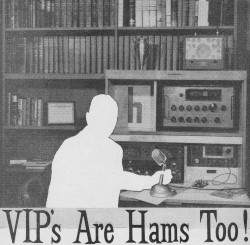 Installing some new radio transmitting equipment
at an Army base in Cyprus after World War II, Staff Sgt. Pappy Henderson found himself
short of several badly needed parts. One evening, while working his ham radio "rig,"
he sent out a CQ and hooked up with D4AFE in Wiesbaden, Germany. Since this was
the location of theater headquarters, Pappy asked the other ham if he knew any "brass"
who could pry loose his urgent request for supplies. Installing some new radio transmitting equipment
at an Army base in Cyprus after World War II, Staff Sgt. Pappy Henderson found himself
short of several badly needed parts. One evening, while working his ham radio "rig,"
he sent out a CQ and hooked up with D4AFE in Wiesbaden, Germany. Since this was
the location of theater headquarters, Pappy asked the other ham if he knew any "brass"
who could pry loose his urgent request for supplies.
D4AFE did considerably better than that - the material was aboard a plane for
Cyprus the same day. What Pappy didn't know was that D4AFE was the then Lt. General
Curtis LeMay, Commander of the U.S. Army Air Forces in Europe!
Like many prominent men with eight-ulcer jobs, General LeMay, now four-star Vice
Chief of Staff of the Air Force, finds needed relaxation through informal radio
chats with "neighbors" - perhaps thousands of miles away - through the twentieth-century
magic of amateur radio.
One of LeMay's close friends is also an amateur radioman, who got his start as
a Navy radio operator. Later he turned to the field of radio entertainment, and
built up quite a reputation. Radio amateurs know him as K4LIB; you know him as CBS
network star Arthur Godfrey.
Even though Godfrey spends many hours each week using radio and TV professionally,
he finds amateur radio a relaxing and enjoyable hobby. When he went on a hunting
trip to Africa with LeMay last year, they brought along some ham radio gear and
kept in touch with the folks in Virginia.
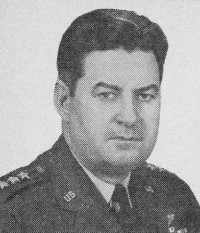 Gen. Curtis LeMay, D4AFE
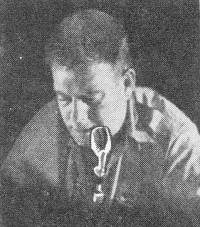
Arthur Godfrey, K4LIB
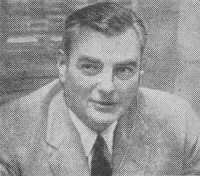
Herbert Hoover, Jr., W6ZH and K6EV
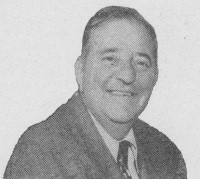
William J. Halligan. W9AC
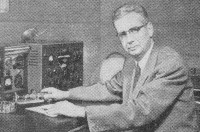
Arthur Collins. W0CXX
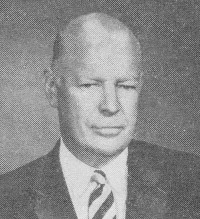
Allen B. Du Mont
Profitable Hobby. Amateur radio is one of the few fields in
which you can be a professional without altering your status as an amateur. A very
democratic fraternity - Godfrey and LeMay are known to hundreds of fellow-hams by
their first names - America's 160,000 FCC-licensed amateurs come from all walks
of life, all ages, all races and creeds, drawn by the attractions of this scientific,
many-sided hobby. Some enjoy building equipment, trying out all sorts of circuits
and ideas. For others, tinkering as amateurs has led to profitable and enjoy-able
careers.
Arthur Collins, for instance, first built ham rigs for himself. When other hams
became interested in his designs, he formed the Collins Radio Co. and started producing
amateur equipment commercially in the 1930's. Today, still a ham (W0CXX), and still
producing top-grade ham gear, he heads one of the largest companies making aircraft
radio equipment for the airlines and the military.
Another company well known to amateurs and short-wave listeners - Hallicrafters
- was founded by amateur William J. Halligan, W9AC. Gilbert Gustafson's hobby, too,
has led to a solid career: he is a vice-president of Zenith, in charge of engineering
for the huge radio-TV manufacturing concern, while still hamming with the call W9AQS.
HOW TO GET YOUR HAM LICENSE
You don't have to be rich, famous, or an engineer to become a ham. There's no
age limit, at either end of life, and there's no charge for the licenses which are
issued by the FCC to those who have qualified. Children as young as six have passed
the Novice Class examination; one old gent is still hamming at 92.
You can take your studying in easy stages, with actual on-the-air practice in
between. The Novice exam requires only an International Morse Code speed of five
words a minute - sending and receiving - and a simple written test mainly concerned
with FCC rules governing amateur operation. This license is good for a year, and
allows low-power operation in four amateur bands, including one band for voice conversations
and three for code.
From this license, you can go on to one that's tougher technically but that doesn't
require any increase in code speed. This is called the Technician license, and permits
operation in most of the very-high-frequency bands. It is becoming very popular,
especially in the larger cities and metropolitan areas. A Technician license is
good for five years, and can be renewed easily.
The goal of most hams is possession of a General Class license, requiring 13
words per minute in code, and a fairly thorough (though not too tough) exam in radio
theory as well as regulations. The General Class amateur can operate "phone" (as
hams call voice), code, or radioteletype in every authorized amateur band, and can
even operate TV and facsimile in some bands. This license, too, is good for five
years and is renewable.
You can either build or buy your equipment. Most hams buy receivers already assembled
and tested, because proper checking of a complicated communications receiver usually
takes a fair amount of skill and considerable equipment. Some hams build transmitters
from scratch, either with a design of their own or one which has appeared in a magazine
or technical book. Others buy kits containing the necessary parts, punched chassis,
cabinets, knobs, tubes and all, and build their transmitters according to detailed
instruction books furnished with the kits. Still others prefer to buy their transmitters
wired, tested and ready to plug into the wall.
Adequate transmitting and receiving antennas can be made from wire even by inexperienced
people. Later on, you might want a more complicated directional antenna shaped like
those used for TV but usually quite a bit larger; there are several types available
from many different manufacturers.
Dr. Allen B. Du Mont, TV pioneer and head of Du Mont Labs., and Ross D. Siragusa,
president of Admiral Corp., while no longer hams, got their start in this hobby.
Two well-known scientists, E. Finley Carter, director of the Stanford Research Institute,
and Cyril J. Staud, vice-president for research of Eastman-Kodak, are long-time
amateurs, with the calls K6GT and K2DQ respectively.
Amateur radio is a proving ground for new ideas. Lt. General Francis H. Griswold,
deputy chief of the Strategic Air Command, was quite impressed with the compact
yet highly effective "single-sideband" equipment used by amateurs. A ham radio operator
himself, Griswold averted the delays which would have been inevitable through professional
and military tests and evaluation of the new system - he installed amateur sideband
gear in several SAC aircraft and found he could maintain two-way contact with amateurs
all over the world while the huge bombers were navigating the globe. Its practicality
and efficiency thus quickly proved, the new sideband form of voice transmission
has now become the standard for military aircraft.
BOOKS ON AMATEUR RADIO
A set of four useful booklets called the "Gateway to Amateur Radio" is published
by the American Radio Relay League, which provides technical books and booklets
at reasonable cost to amateurs and would-be amateurs.
Included in the set is the "Radio Amateur's License Manual," which contains the
full text of the FCC regulations, sample questions and answers, information on where
to obtain application blanks and exam papers, and other useful material. A second
booklet, "How to Become a Radio Amateur," shows you how to build simple transmitters
and receivers, and explains in simple terms what makes radio work. The third one,
"Learning the Radiotelegraph Code," not only tells you how to learn the code, but
includes practice material and suggestions for constructing buzzers or oscillators
so that you can send the code. The remaining booklet, "Operating an Amateur Radio
Station," explains many of the "Q-signals," abbreviations and jargon that hams use,
and in addition, describes the ARRL and its services.
The "Gateway to Amateur Radio" can be obtained in most radio parts stores, or
you can write Department P, American Radio Relay League, 38 La Salle Rd., West Hartford
7, Conn., for further information.
Specialized Hams. But this hobby is not reserved for engineers
and engineers-to-be. Its other facets are appealing to people with little scientific
or mechanical bent.
There are the "DX hounds," those who try to hold chats with amateurs in as many
different countries, possessions and territories as possible. There are "traffic
men," who meet on the air regularly in networks to relay messages for other amateurs
and the general public, free of charge.
There are contest fans, who delight in the fast and snappy operating to be found
in numerous contests sponsored by the hams' national organization - the American
Radio Relay League, foreign societies, and local clubs throughout the country. And
there are the hams who specialize in emergency preparedness; through regular drills
on the air, they maintain a vast network ready to go into operation whenever floods,
fires, hurricanes, storms, or other disasters disrupt normal communications facilities.
Perhaps the largest group - and one which attracts virtually all hams at one
time or another - is called the "rag-chewers." These friendly folk like to make
new friends by radio, chatting at length about all sorts of things.
From All Walks of Life. Back in 1928, two California hams met
by radio and were enjoying a rag-chew. One of them, a Democrat, talked at some length
about the virtues of Alfred Smith, who was running for president that year against
Herbert Hoover. The other ham didn't seem to have too much to say, and soon signed
off. The first wondered a little, then picked up his ham directory to address the
usual QSL (acknowledgment) card. The amateur at the other end of his campaign talk
turned out to be Herbert Hoover Jr.!
The younger Hoover, now rather well known himself as a petroleum engineer, as
a trouble-shooter for the State Department, and as Under Secretary of State from
1954 through 1957, has ham stations at both his home in Pasadena (W6ZH) and his
summer home in Santa Barbara (K6EV).
In the field of music, there's Tex Beneke, who took over the Glenn Miller orchestra
after the death of its renowned leader. He and his wife Marguerite have both been
hams for several years; now living in St. Louis, they are licensed as K0HWY and
W0EHR respectively. Peewee Hunt, another well-known orchestra leader, operates W8HBC
in Columbus, Ohio. W6UK in North Hollywood, Calif., is owned by the noted guitarist
Alvino Rey.
Among royalty, Crown Prince Feisal and five of his royal relatives are amateurs
in Saudi Arabia. Former Archduke Anton of Austria was such an ardent amateur that
when the Germans occupied his country just prior to World War II he continued operating
in a ham radio contest, surrendering only after the contest was over. He survived
the war, incidentally, and now is licensed under the calls OE3AH and OE5AH as plain
Anton Hapsburg. And the Maharajah Kumar of Sikkim, P. T. Namgyal, is one of the
two amateurs in the remote Himalayan country, with the hotly-sought-after call AC3PT.
Relaxing on the Air. Others of the nation's top military men
enjoy hamming as a relaxing hobby. Rear Admiral Henry C. Bruton, Director of Naval
Communications, has been a ham a long while, as attested to by his "two-letter"
call, W4IH. Brig. Gen. Joseph Stilwell, Jr., son of "Vinegar Joe" Stilwell of World
War II fame, is licensed as W4FPE.
Former Commissioner George E. Sterling, who retired from the Federal Communications
Commission in 1954, and previously had served in the Radio Intelligence Division
and as Chief Engineer of the FCC, has been an active ham for years, with the calls
W3DF and WIAE. A prominent hotel executive, Ernest Henderson, president of the Sheraton
Hotel Corporation, operates WIUDY near Boston, Mass. W0HBG is the call assigned
to Clyde Hendrix, vice-president of Pillsbury Mills. The City Manager of Superior,
Wisconsin, W. R. L. Taylor, hams with the call K9IGF. And there is even a ham who
is a professional wrestler - "Flash Gordon" Walker, K4INN.
Posted July 21, 2022
(updated from original post on
7/10/2012)
|









 Installing some new radio transmitting equipment
at an Army base in Cyprus after World War II, Staff Sgt. Pappy Henderson found himself
short of several badly needed parts. One evening, while working his ham radio "rig,"
he sent out a CQ and hooked up with D4AFE in Wiesbaden, Germany. Since this was
the location of theater headquarters, Pappy asked the other ham if he knew any "brass"
who could pry loose his urgent request for supplies.
Installing some new radio transmitting equipment
at an Army base in Cyprus after World War II, Staff Sgt. Pappy Henderson found himself
short of several badly needed parts. One evening, while working his ham radio "rig,"
he sent out a CQ and hooked up with D4AFE in Wiesbaden, Germany. Since this was
the location of theater headquarters, Pappy asked the other ham if he knew any "brass"
who could pry loose his urgent request for supplies. 





